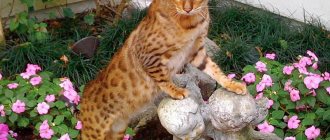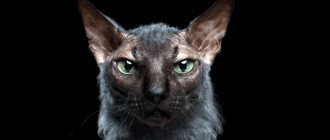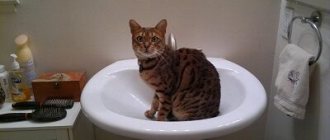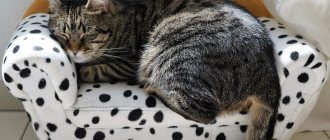Each furry pet, be it a purebred representative of a rare breed, a hybrid or a “yard” inhabitant, is unique. But from the motley cat brotherhood, the chocolate Yorkie cat . The cat with delicate brown fur and flexible character is rapidly gaining fans around the world. Despite the lack of recognition by most international organizations and the rich history of breeding the breed, the handsome Yorkie easily wins over cat lovers thanks to his attractive exterior with hints of exoticism combined with a friendly disposition.
History of the origin of the breed
In 1983, American Janet Chifari got a kitten with chocolate-colored fur. It was a cat who was named Brownie. Later, a male of the same color was born. This gave Janet the idea of developing a breed with a distinctive color, and in 1985 she began breeding the breed.
Four years later, there were already 27 kittens of the new breed in the Chifari nursery. Another year later, York Chocolate was recognized by CFF and ACFA. In 2009, the breed received new breed status in the ACFA association, as well as champion status in the CFF and WCF.
The breed received its name in honor of the city of New York, where it was bred.
Features of color
The formation of color is a complex biochemical process that begins in the embryonic stage of embryonic development. The color of a future kitten's fur depends on the interaction of dozens of genes.
- Chocolate color is one of the forms of black, for which the B gene (black) is responsible. In combination bb it gives the color range of a brown monochrome, capable of taking on different tones.
- Next, the D gene enters the process. In the dominant form, it blocks any lightening, but in the recessive version, dd opens the way for a change in the color of the main pigment.
- The bb (brown) allele and the dominant D gene are chocolate color. When the combination bb+dd occurs, the coat lightens and turns purple.
- Black always dominates brown.
- Within colors there are also divisions into tones. Dark chocolate is formed by the b allele, and the lighter cinnamon (cinnamon) received the b index
- Option b partially suppresses b1, making color fixing a very difficult task. Therefore, kittens change color over time, and only in an adult animal can one accurately determine the color of the coat.
- In nature, cats have two coloring pigments - black eumelanin and red pheomelanin. But the first one has two additions - brown (dark chocolate) and cinnamon (cinnamon color). The color saturation of the hair is affected by the shape of the dye capsules and the density of their arrangement in each hair.
Experienced breeders always accurately determine what colors cats will have in their litter. Brown color is considered rare and complex, but in some cases it predictably appears when breeding chocolate cats.
This is interesting! Once upon a time, felinologists tried to get brown offspring from red (ginger) cats. But the experiments had to be stopped due to unstable results. Only some varieties of black cats give birth to chocolate babies.
Description of the breed
WCF standard for the breed
- Body. The body is large, proportional, chest and shoulders are of the same width.
- Neck. From medium length and more.
- Head. Medium proportions, wedge-shaped. The forehead is rounded, the nose is straight, longer than average.
- Limbs. They are distinguished by their slenderness, oval-shaped paws, with tufts of fur between the toes. The rear ones are located higher than the front ones.
- Tail. Thickened at the base, tapering towards the end. Length, from medium and above.
- Eyes. Oval, medium size. They are located at an angle to the nose. Color
- Wool. Soft, silky, shiny. Shorter on the shoulders than on the back. Medium length, thin hair.
- Ears. Wide at the head, slightly pointed, with fur on the inside. Large, leaning forward.
- Color. Chocolate. It can also be lilac and chocolate lilac with white.
The history of the appearance of chocolate color among the British
In the middle of the 19th century, Great Britain was recognized as the center of world felinology. Along with warriors and traders, exotic cats migrated to the kingdom, adapted to the new climate and gradually formed a stable aboriginal population.
England, of course, has something to be proud of in the development of cat traditions. The first official exhibition of four-legged pets took place here. In 1871, the Crystal Palace in London's Hyde Park was allocated for this event. This is where the history of public shows and competitions among cats of different breeds began.
At first, the British were bred with a gray-blue color, which later became established in the breed and was recognized as the standard for it. Later, mass selection occurred, resulting in about 250 color combinations.
They, in turn, were divided into 6 groups:
- solid;
- tabby;
- smoky;
- tortoiseshells;
- two-color;
- color-point.
British chocolate kittens are part of the solid color group. There is an opinion that this coat color appeared as a side effect after mating with Persians, Siamese, Burmese and Oriental cats.
Breeders sought to obtain an acromelanic mask, and with it the chocolate color came to the breed. Later, all that remains is to strengthen it, achieve uniformity and consolidate it in the offspring.
It is known that the first “chocolates” appeared at cat shows in the mid-80s, and only a few nurseries in the world dealt with them. Later, the list expanded, but due to difficulties in breeding and high risks, the chocolate British never entered the mainstream. And now they are considered rare species of cats even in their homeland.
Appearance and photos of the Yorkie chocolate cat
It is believed that the Yorkie cat borrowed its chocolate color from its Siamese ancestors. The first time after birth, kittens may have a tabby pattern and tipping (when only the tip of the hair is colored, but the main part is not). But they disappear by about 18 months of life.
These are quite large cats. The average weight of a male reaches 8 kg. Females weigh less. The body is thin, graceful, long and muscular.
Chantilly
A very rare breed with mysterious origins. Its first representatives were found in a house bought by a British family. There lived two cats whose fur had an amazing chocolate shade.
Source: uf.ru
Subsequently, this breed acquired other interesting colors - cinnamon (cinnamon), golden, black, beige. They also have a very good character - affectionate, friendly and sociable cats can be excellent companions. Interestingly, Chantilly is not the first name of the breed. At first, these cats were supposed to be called “foreign longhair,” but this name was considered too impersonal. The second was “Tiffany” - later they also abandoned it. But “Chantilly” has taken root quite well.
Source: www.royal-canin.ru
Character
Photo. Yorkie chocolate cat
The Yorkie cat is distinguished by its friendliness, sociability and affectionate disposition. She loves attention and affection, gets along well with all family members, including four-legged ones. However, some females may have a dislike for excessive affection - such a cat will “help” the owner around the house, sleep next to him, even climb on his lap, but will not allow him to be picked up, stroked or sleep in an embrace.
Yorkie cats are excellent mousecatchers, therefore, when keeping tame rodents in their neighborhood, you need to carefully monitor the behavior of the animal. Having become accustomed to such “cohabitation,” the chocolate cat will behave quite peacefully, especially if it has never hunted mice. If a cat lives in a private home, they should be kept away from hamsters, tame rats or guinea pigs. He treats dogs and other cats calmly, even kindly.
Loneliness is intolerable for a pet of this breed.
Cats need to be close to a person and receive their portion of attention from him. They love active games. They adapt well to various living conditions and feel great both in a city apartment and in a private home. Easily adapt to changes in place of residence.
They treat strangers and animals with caution and evaluate them by observing from a distance. If observation does not reveal any signs of danger, the Yorkie will definitely want to get to know each other better and even make friends.
Castration and sterilization
When an animal is not needed for breeding, it is spayed or neutered. The earliest age for castration is six months. By this time, the cats’ bodies will already be fully formed. And so cats can be castrated or sterilized at any age. For cats, surgery is performed no earlier than the first heat cycle ; only after it is the body considered fully formed and mature. If the cat comes to you as an adult, then you can operate on it at any age, paying attention to its health condition.
Caring for your cat after surgery
The operations are quite easy, but the animals still need care after them. The operation is performed under anesthesia, so you need to monitor the animal for some time until it recovers from anesthesia. This is necessary in order to bring the animal to its senses in case of problems, give a heart massage or the necessary injection.
Transportation from the veterinarian to home should take place in a soft carrier, with a warm blanket or bedding at the bottom. At home, the cat is placed on a soft and warm bed away from windows and doors to avoid drafts. The cat must be wearing a blanket to prevent it from licking the stitches. There should be clean water near the animal. The cat should be fed no earlier than one day after the operation. Food - light and liquid, broth or fermented milk products.
Postoperative blankets are placed on cats to prevent them from licking the stitches.
After surgery, the cat’s sutures are treated twice a day with cotton swabs and hydrogen peroxide, or Chlorhexidine can be used. After treatment, they are lubricated with Levomekol ointment, it helps to heal the wound faster. After 14 days, the stitches are removed.
Nowadays, in most veterinary clinics, operations are performed using a seamless method, which is considered the best for sterilizing pets.
Care and maintenance of the breed
York chocolate cat is not fussy in care and maintenance
Completely undemanding in care. Apparently, this quality was inherited from their mongrel ancestors . This breed is suitable for almost any living conditions.
All a Yorkie cat needs is a loving owner, active games and a balanced diet.
The only thing that should not be ignored when caring for a cat of this breed is brushing the fur. You should brush your pet once a week. If this is not done, the wool may lose its attractiveness.
Keeping a pet
For your pet to be healthy, mobile and active, it needs proper care and proper nutrition.
Nutrition
When you bring a small kitten home, questions about feeding and care immediately arise. The breeder of the sold kitten should tell you all the details, and at the same time give you some food for the first time. A small child eats 4–5 times a day. It is advisable that there is always food and clean fresh water in the cup, possibly from a filter, but not boiled. Food: dry food, preferably premium. You can add a little cottage cheese, fermented baked milk or kefir.
What to feed an adult cat is up to you. There are two options - continue to feed the animal with dry food from good quality producers or switch it to natural food. An adult cat needs to be fed 2-3 times a day in small portions, clean water is always required.
If you decide to switch your pet to natural food, then you cannot give any food from your table. Only vegetables, eggs, boiled fish, meat, cereals, and low-fat dairy products are suitable.
If you want to treat your animal with cheese, sausage or other tasty treats, then they can be given as a treat or reward for something, but not very often. If the food is natural, then you should not forget about vitamin complexes for cats; they will contain all the substances that are useful and necessary for the cat, which may be lacking in natural food.
With a natural diet, it is necessary to give cats vitamins
Cat care
Since the Yorkie cat has long hair, it requires constant care. You need to bathe your cat as soon as it gets dirty, preferably once a month. You need to wash the animal with shampoo, after bathing, thoroughly dry the coat with a hairdryer and comb it.
The luxurious fur of Yorkie chocolate cats requires constant care.
You need to comb the fur with a special comb 2-3 times a week so that it does not mat and does not have to be cut later. I had a Persian cat that I didn’t have time to care for. The wool became felted like felt boots and had to be shaved off. Then the cat walked like a lion - bald, but with a mane on his head.
In addition to the coat, you need to take care of the ears, teeth, claws and eyes. Nails should sometimes be trimmed with special scissors. The ears are cleaned 1-2 times a month with a cotton swab and special drops; they can be purchased at a veterinary pharmacy. If your cat's eyes are running and watery, you can use eye drops. Your cat's teeth should be brushed with a special brush and toothpaste.
Your cat's ears need to be cleaned a couple of times a month.
Do not forget about treating the animal against various fleas, ticks, worms and other parasites. Treatment for worms is carried out once a quarter with special preparations (for example, Drontal, Stronghold, Prazicide, Polyvercan). A variety of drops, tablets and collars are sold against fleas and ticks. You can choose the option that is convenient for you and your animal.
Every cat needs a toilet. Any cat litter box is perfect for this. To avoid odor, you can purchase cat litter. It can be very different - wood, silicate, cellulose, clay. Each filler has its own advantages: one eliminates odor, the other is easy to remove.
In my opinion, the best filler is wood. I have two cats and I only put this in their trays. The filler has a fairly low cost and good quality. Immediately absorbs all the liquid, locks out unpleasant odors and is very easy to replace with a fresh one.
Since the breed is very active, you can walk it. If you have a private house, then everything is very simple - at any time you can open the door and let the cat out for a walk in the yard, catch birds or play with other animals. You will have to go for a walk from the apartment with your pet so that it does not run away. You can use a special cat harness for walking; it does not restrict the animal’s movement.
Yorkie Chocolates are very active and will happily go for walks.
Feeding
In feeding, as well as in care, cats of this breed are completely unpretentious. Both dry and natural food are suitable for them. Among dry foods, premium food intended for the Persian breed is best.
Yorkie chocolate cat can be fed with almost any meat
– lamb, veal, chicken, rabbit, lean pork. Be sure to give sea fish - this is a source of vitamin D.
You should not feed smoked meats and some offal, for example, spleen, kidneys, lungs.
Along with proteins, animals need vitamins. It is advisable to grow a special grass, the seeds of which are sold in pet stores. Or germinate grains - wheat, oats.
How many years do they live?
In addition to the standard procedures for cleaning eyes, ears, and trimming claws, it is recommended to periodically take the cat to the veterinarian for a health assessment and more painstaking care procedures. In the absence of serious diseases, a cat can live up to 15 years, but there have also been long-livers who have delighted their owners for more than 20 years.
York chocolate cat breed
Where to buy a Yorkie chocolate kitten
It is almost impossible to buy a real purebred Yorkie in Russia. There are only a few kennels of this breed around the world - mainly in America, a few in Canada. In recent years, nurseries have appeared in Europe, but their number is limited. The breed is quite young and has not yet gained sufficient popularity.
You can buy a kitten of this breed secondhand, but there can be no talk of any purebred. Most often these are kittens of the same yard cats as the ancestors of the breed.
Breeding work
Breeding work with Yorkie cats should only be carried out by experienced professionals who have sufficient knowledge of genetics and considerable practice in cat breeding. Only systematic, thoughtful breeding will help the young breed finally form the desired types of animals and finally get rid of the experimental status and gain universal international recognition.
The nuances of breeding the Yorkie breed
If you are lucky enough to become the owner of a high-quality representative of the breed and have a great desire to engage in exhibition and breeding activities, do not neglect the breeder’s recommendations. The main problem of breeding with this rare breed is the limited gene pool of the producers, which inevitably leads to inbreeding and the accumulation of similar blood, which does not always benefit the offspring.
The problem is especially acute in areas remote from the North American continent. Here it can be almost impossible to correctly select a pair for breeding, and not every owner can afford to fly with a female cat across the ocean for mating every time, even if he is a true fan of his favorite breed.
A compromise solution to the problem could be the acquisition of a breeding pair at once - a cat and a female cat, theoretically well suited to each other in blood and phenotype. But theory, alas, may diverge from reality, and producing a series of identical duplicate litters is boring and unpromising in terms of the development of the breed. Another option is to rent breeding animals; which is troublesome and expensive, but more interesting. In any case, active breeding activities require both enthusiasts and the popularization of a breed that few people still know about.
Thanks to their “yard” genetics, Yorkie chocolate cats have virtually no problems in the reproductive sphere. They get pregnant well and give birth easily, usually giving birth to multiple litters. Mother cats are zealously involved in raising children, in which fathers most often do not take part.
York chocolate cats are caring mothers
Since sexual maturity in representatives of this breed occurs no earlier than two years of age, it is not recommended to rush into mating. In order for a cat to have time to fully recover between births, the interval between them should be at least six to nine months. Animals participating in breeding work must be under the close attention of a veterinarian and receive a “enhanced” diet rich in vitamins, minerals and special additives.
Castration and sterilization
Given the youth and relative instability of the breed, breeders of York cats often make the sale of a kitten that they consider unpromising, neuter or castrate it. This is a completely fair opinion, because only the best representatives of the new breed should build.
However, if you, as an owner, do not plan to engage in breeding, then timely sterilization will make life easier for both you and your animals. Moreover, the natural hormonal levels of male and female Yorkies are usually very high - and this is fraught with both behavioral disorders and serious health problems. It is best to proactively avoid this.
Sterilized animals must be under the supervision of a veterinarian
The optimal age for surgery is from seven to nine months. The operation should only take place in a veterinary clinic. Trust experienced doctors with the rehabilitation of your pet, because this is no less important and responsible than a qualified operation.
How to choose the right kitten
If a kitten is purchased from a nursery, then first of all you should check all the necessary documents, reviews and living conditions of the animals. In this case, purchasing from a nursery is possible only in the homeland of the breed and in several other countries, so you will have to purchase a Yorkie from your own hands.
What should you pay attention to when buying a kitten?
- Check your pet's documents, if available.
- Ask the owner for a veterinary passport. It should indicate all vaccinations that the kittens received.
- If you buy this breed in Russia, most likely it is an ordinary non-pedigreed cat with similar features
Pay attention to his behavior. A healthy kitten will be active and inquisitive. If he is apathetic, with sad eyes, and does not participate in games, most likely the pet is sick.
- Check external indicators. A sick animal may have watery eyes and dull, matted fur. Discharge under the tail indicates digestive problems or infection.
- If you can be present when the kittens are feeding, you should pay attention to the kitten's appetite. Poor appetite indicates the presence of a disease, excessive appetite is a sign of worms.
Catering
Kittens up to three months are fed 6 times a day, up to six months - 5 times, up to a year - 3 times, older ones - in the morning and evening.
If the owner does not have time to prepare food, you can opt for the industrial food option. It comes in 4 quality groups: economy, premium, superpremium and holistic. For show cats, they choose a holistic treatment that has no harmful ingredients and a balanced composition of microelements. If the owner just wants to maintain the health of the pet, you can choose super-premium for long-haired breeds.
You need to know the following about feeding a cat natural food: the presence of pesticides, GMOs, flavorings, artificial additives, hormones in food is not allowed, and the food must be fresh, while 80% of the diet is proteins, the rest is vegetable fats, carbohydrates (energy source) , fiber (for digestion), trace elements and vitamins (calcium, iodine, selenium, magnesium).
- Protein sources: meat (chicken, turkey, rabbit, veal, lamb - every day), fish (twice a week), raw eggs (every 2 days), low-fat cottage cheese and kefir (every other day), unsweetened yogurt, hard unsalted cheeses (once a week).
- Fiber and carbohydrates: porridge (barley, oatmeal, liquid semolina), vegetables and fruits (broccoli, pumpkin, cauliflower, apples, carrots, zucchini, green beans, cucumbers). Include in your daily diet.
- Sources of fats: 2 drops of vegetable oil or fish oil in porridge.
- Microelements and vitamins: supplements (only on the recommendation of a veterinarian), brewer's yeast.
Regardless of the type of food, the cat should always have access to fresh, warm water.
Owner reviews
Elena. My Yorkie cat is already 6 years old. She is smart, very sociable, but does not like to be petted. If she wants to be in company, she sits nearby. Accompanies me everywhere around the house, participates in all household chores. But it doesn’t get tangled under your hands and doesn’t get in the way.
Olga. A very beautiful and unpretentious breed. We've had this one for several years now. Smart, affectionate. There is a dog in the house - they get along great, even sometimes play together. Eats any food - meat, liver, boiled eggs. Likes to sleep on feet.
Marina. We have a cat of this breed. Very pleased. Good at catching mice. This is important since we live in a private house. He is not picky about food and loves chicken very much. There were no health problems. Affectionate, loves to be petted and played with.
Diseases
The breed has no hereditary diseases. At the same time, individuals have a fairly strong immune system due to their yard roots and are rarely exposed to diseases, especially if all vaccinations have been completed:
- Deworming once every 3 months;
- Treatment for external parasites;
- Vaccinate annually against rabies and feline infections.
Yorkie cats do not have genetic diseases, but require vaccinations
The most common ailments are related to the condition of the coat, teeth, ears and joints:
- Problems with the coat: it becomes dull, dandruff appears, bald spots appear, a small rash is visible on the skin. The most likely cause is damage from lice, lice or fleas.
- Ear mite. Symptom: brown plaque in the ear. If you do not contact a veterinarian in time, the presence of the parasite will cause an inflammatory process, and then the occurrence of eczema. For treatment, the doctor prescribes antibiotics and rinses.
- Allergy. Often associated with non-compliance with diet, less often flea bites. Symptoms: the cat scratches nervously, blisters and eczema appear on the body. Treatment consists of eliminating the allergen and supportive therapy.
- Symptoms of intestinal and stomach diseases: refusal to eat, vomiting, diarrhea, sudden loss of body weight, mucus or blood in the stool. The cause may be infectious (parasites, virus, bacteria) or non-infectious (intestinal obstruction, tumor in the stomach or intestines). Treatment is prescribed by a veterinarian depending on test results.
Breeding and choosing a kitten
Yorkie cats are quite rare, but their breeding is not prohibited for novice breeders. However, before opening a cattery and starting breeding cats, it is necessary to take felinological courses and cat genetics courses. You will have to buy a couple of cats in America or Canada - now there are nurseries only in these countries. For breeding, a show class cat or a breed and a show class cat is suitable. Also, animals must be absolutely healthy and compatible by blood group (A and B):
- cat A - cat A and B;
- cat B - cat B;
- cat A - cat A;
- cat B - cat A and B.
It is necessary that the cat and the cat match in color
Remember that each kitten must have a confirmed pedigree without being marked “pet” or “without the right to breed.” If you decide to purchase adult cats (it is easier for a novice breeder to choose good cats of an already established type), then they may also have breeding grades and titles. In chocolate Yorkies, the color is finally formed by the age of 2, so it is difficult to say until this age what the cat will be like.
The Yorkie matures at about 6–7 months, but this is too early an age for pregnancy, so cats need to be bred at 1.5–2 years.
Before mating, both cats must receive breeding grades at the exhibition (the male is not lower than “excellent”, the female is not lower than “very good”), which are valid for 2 matings. If a cat completes a title within several shows and receives a title certificate, it is valid for life. Another procedure before mating is to obtain permission for mating from the organization or club in which your nursery is registered.
Before mating, a Yorkie cat must receive a breeding assessment.
Mating takes place in a safe and quiet place, preferably in a separate room. Usually lasts 2–3 days. It is necessary to bring cats together on the 2nd–3rd day of the cat's heat.
Pregnancy lasts about 60–65 days. It can be determined by a change in the cat's behavior and an enlargement of the abdomen. By the 3rd week, the cat's nipples will swell and turn pink, as well as an increase in appetite and food preferences may change. A litter usually contains 2 to 6 kittens. The litter must be registered with the club within 8 weeks of birth.
Choosing a kitten
How to choose a Yorkie chocolate cat kitten:
- kittens do not yet have such an intense color as adults - they are lighter, but the color is also homogeneous and uniform;
- eye color corresponds to the standard;
- The kittens' fur is quite thick, very soft and silky, with a thick undercoat;
- the ears are set wide apart, the distance between them is no less than the length of one ear;
- the distance between the eyes is not less than the length of one eye;
- the muzzle is slightly elongated, wedge-shaped, the ears continue the lines of the wedge;
- The body is quite long, as are the legs.
The price of kittens varies from $400 to $1000.
Yorkie cats are a fairly small breed.











